MSI’s GeForce N470GTX & GTX 470 SLI
by Ryan Smith on July 30, 2010 1:28 PM ESTGTX 470 SLI: Power, Temperature, & Noise
Wrapping up our look at the GTX 470 SLI, we’ll take a look at power, temperature, and noise. We have already well-established that GF100 cards can be particularly power hungry compared to their Radeon competition at similar performance levels, so this will give us a chance to see just what the situation is like when we throw multi-GPU in to the mix.
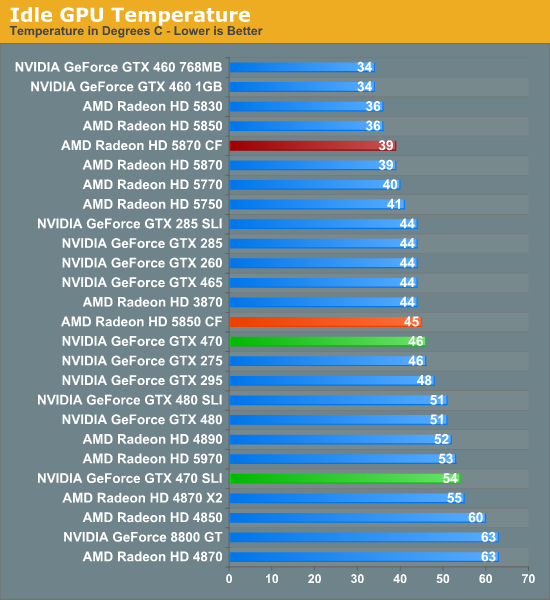
Having 2 video cards usually has a negative effect on idle conditions, and the GTX 470 SLI is no different here. Having a second card blocking the first pushes the temperatures of the first card up by 8C.
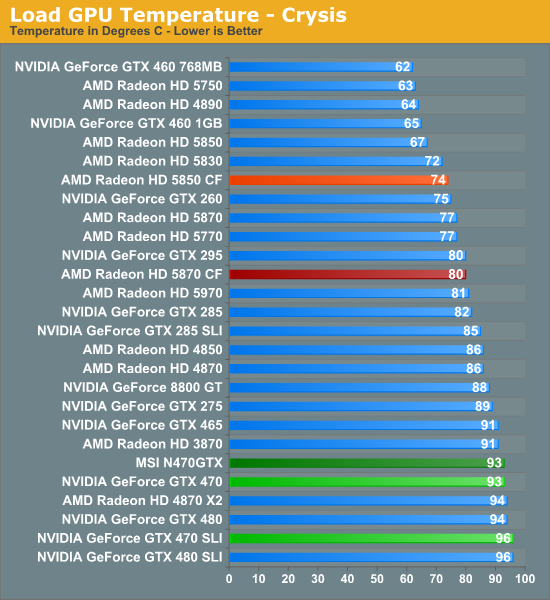
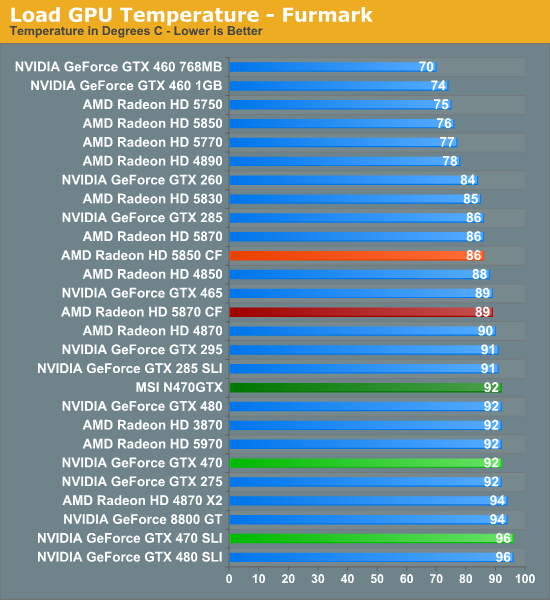
Load temperatures are similarly affected. The GTX 470 SLI ends up performing just like the GTX 480 SLI here, peaking at 96C under Crysis and stabilizing at 96C under Furmark. NVIDIA strongly suggests separating GTX 400 cards when in SLI for this exact reason – these results are when we already have a fan behind the cards. The Radeon cards do end up in a similar situation, but ultimately they still stay below 90C when in CF mode.
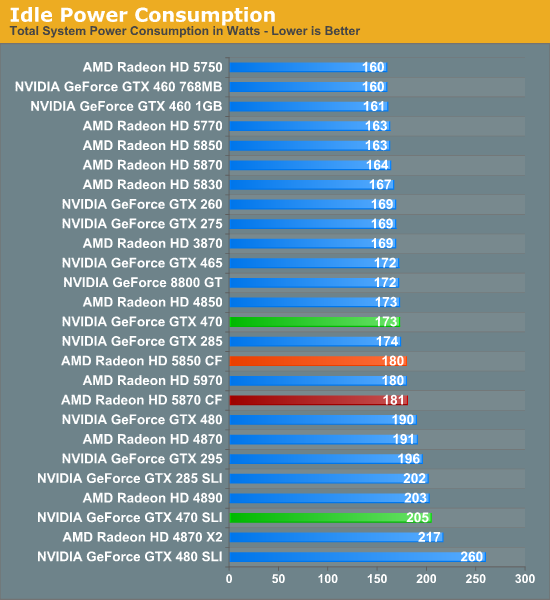
Compared to the GTX 480, the GTX 470 has noticeably lower idle power consumption, which cascades in to our SLI results. The 470 GTX SLI ends up consuming 55W less than the GTX 480 while idling, while consuming around 25W more than the Radeon cards in CF mode.
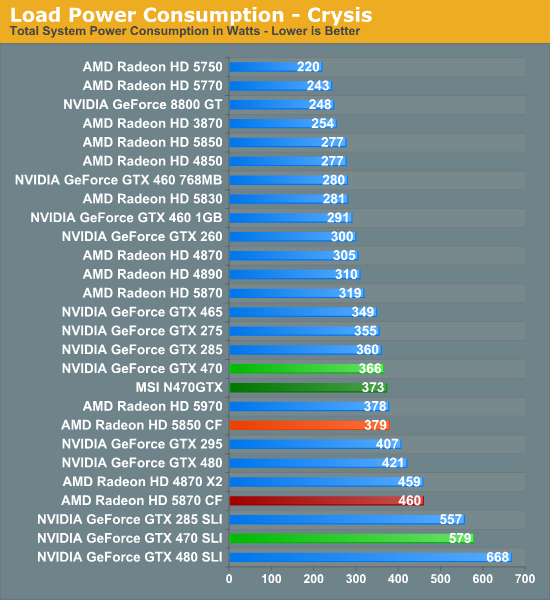
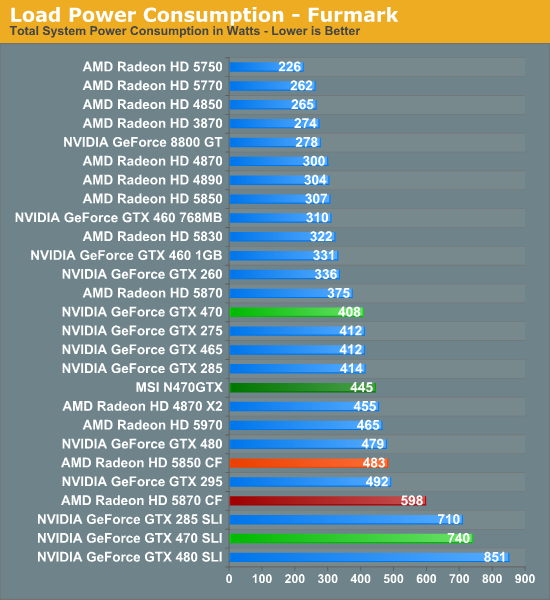
When the GTX 480 SLI became the most power hungry dual-GPU setup we’ve ever tested, there was little reason to believe that the GTX 470 SLI wouldn’t follow it, so these results shouldn’t be surprising. With Crysis the GTX 470 SLI pulls nearly 100W less than the GTX 480 SLI, but it still pulls between 100W-200W more than the Radeon cards in CF. Furmark is a similar story, but here the difference between the GTX 470 SLI and the Radeon cards is now 150W-250W.
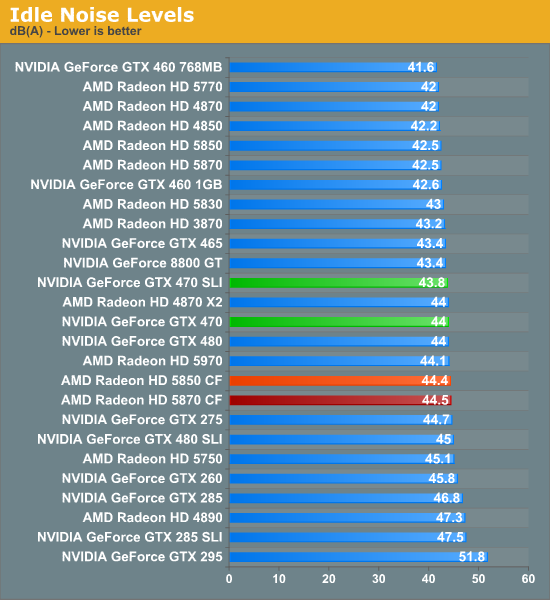
Idle noise is more or less a solved problem. The vast majority of modern coolers emit almost no noise when idling, resulting in SLI having little impact on idle noise.
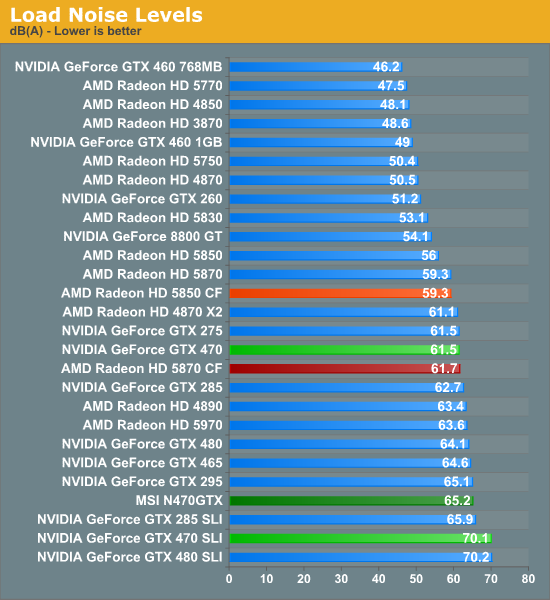
Our noise charts usually closely follow our power charts, so these results should not be surprising. With the partially obstructed GTX 470 card exceeding 90% of its top fan speed, the SLI combination is second only to the GTX 480 SLI. This is 8dB-11dB louder than the Radeon cards, and makes the GTX 470 SLI the clear winner/loser for the second-worst spot on our load noise charts.
Overall these results closely mimic what we saw with the GTX 480 SLI back when it launched: 1 GF100 card is hot & loud, and 2 cards are even hotter and louder. As the saying goes: cheap, quiet, high-performance – pick any 2.










41 Comments
View All Comments
Tunnah - Sunday, August 1, 2010 - link
seems my comments are being taken out of context, sorry guys not used to posting on a board i'm an IRC kind of guymy overshadowing comment was in reference to SLI only
was asking why study the 470 SLI at the moment when the 460 seems to be grabbing more headlines, especially with it's scaling capabilities
the 460 SLI numbers were what i was asking about, as from what i've read in other reviews the scaling is amazing and it brings it up against, and sometimes passes, the 5850 in XF
even though i know a big SLI round up is coming it just seemed weird to focus on the 470, but as they say they've been waiting for a second one to do SLI testing for a while..
mapesdhs - Saturday, July 31, 2010 - link
I see the 8800GT in the test setup summary, but why no results for it (especially SLI) in
the performance tables?
Ian.
Perisphetic - Sunday, August 1, 2010 - link
A picture of twin jet engine exhaust on the sticker & a software that's called afterburner. Can this be used for this new type of hot air drilling or just plain marshmallow roasting???Perisphetic - Sunday, August 1, 2010 - link
But jokes aside, where in the software is the setting for heat shrinking tube?nmctech - Monday, August 2, 2010 - link
I noticed a few days back they released the Quadro Fermi cards 4000, 5000 and 6000. I found a couple of gamer reviews but a more thorough review of the cards for 3D use would be nice.Have you guys had a chance to check those out yet?
mapesdhs - Wednesday, August 4, 2010 - link
I expect they'll review them eventually, but more likely reviews for the new cards
will appear on other sites first, eg. those aimed at users of Maya, ProE, CATIA, etc.
Presumably they'll run Viewperf, Cinebench, etc. among other things. I have two
Quadro FX 5500s to test (after which I'll put them up for sale), so I can gather
some results, post the data on my site for comparison to whoever reviews the
newer cards. If anyone here is interested, let me know (mapesdhs@yahoo.com)
and I'll send out a URL when the tests are done.
Btw, I was surprised to see NVIDIA's summary shows the 5500 is 3X faster than
the 5800:
http://www.nvidia.com/content/PDF/product-comparis...
so it should be interesting to see how two 5500s SLI compare to the new 6000,
sans any differences in CPU/RAM/mbd that might affected the results (my system
is a 4GHz i7 860, so the two cards will be running 8X/8X for SLI).
Ian.
hsew - Tuesday, August 3, 2010 - link
I wish SOMEBODY would do an article on multiple GPU scaling , CFX and TriSLI, on AMD vs Intel.Something like:
Core i7 980X, Core i7 9xx, Core i7 8xx, Core i5 7xx, Core i5 6xx, Core i3 5xx.
Phenom II X6, X4, X3, X2, Athlon II X4, X3, X2.
all systems 4GB ram each.
Now, I know that such an article would likely take an astronomical amount of time to write, BUT, it would answer a seriously nagging question:
Do you really need four or more cores in a Multi-GPU system? Do you even need an Intel CPU to effectively run a Multi-GPU system?
Exelius - Wednesday, August 4, 2010 - link
I think the reason this hardware is so boring is that the difference between low-end cards and high-end cards is so high. Low end cards are far more popular though; and game companies aim for the lowest common denominator. Thus there is no market for exciting cards because there are no games that can use them.NVidia knows this; and are desperately trying to find a new market for their hardware. ATI knew this, which is why the merger with AMD happened. I'm guessing NVidia won't last long as an independent company; Fermi for HPC isn't catching on quickly and I don't think NVidia is in a stable enough position to convince HPC users to begin the costly and time consuming project of moving to Fermi. I think they need an Intel, IBM or HP behind them for that to happen.
But yes, PC graphics have become boring. Blame $400 PCs and smartphonea for that.
Heatlesssun - Saturday, August 7, 2010 - link
Haven't played with a high-end system lately have you? Graphics boring on high-end PCs, you gotta be kidding me! 3D Surround, just amazing stuff that that $400 PC and smart phone need not apply.Patrick Wolf - Monday, August 16, 2010 - link
It'd be great if you explained under what conditions you record temps. Things like using a case or an open bench? Are there any additional fans blowing on the card(s)? Room temp? How long do you run Furmark and what settings are used?